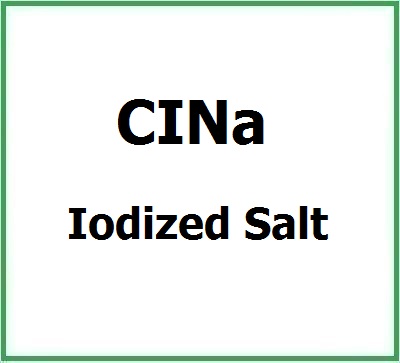Sea salt or iodised salt has ancient origins. The Phoenicians first and then the Romans, traded this salt selling it at a high price, so much so that it was later called the white gold. It was one of the cornerstones of the ancient economies that were handed down the art of extraction and refining of this product.

The salt pans of Trapani in Italy, still active today, were probably planted 2500 years ago by the Phoenicians.
The production is addressed to these sectors:
- Domestic consumption
- Wholesale
- Chemical, Pharmaceutical, Tanning, Textile Industry, etc.
- Water purification
- Antifreeze for road surfaces
2.2 billion people in the world live in areas with iodine deficiency (1) that can damage the thyroid gland. But this valuable gland can be damaged by both iodine deficiency and excess iodine and the diseases that can be traced back to it for deficiency are endemic goitre, cretinism and hyperthyroidism. On the other hand, an excess of iodine can lead to chronic lymphocytic thyroiditis, hyperthyroidism and hypothyroidism (2).
Molecular Formula CINa
Molecular Weight 58.44
CAS 7647-14-5
Sea salt studies
References____________________________________________________________________
(1) Khajedaluee M, Rajabian R, Seyyednozadi M. Education achievements and goiter size ten years after iodized salt consuming. Int J Prev Med. 2013 Aug;4(8):876-80.
Abstract. Background: Approximately 2.2 billion (2200 million) of the world population are living in the area with Iodine deficiency (ID), most of them in the developing countries. In IRAN about 2 million are exposed to Iodine deficiency. Most of the complications of ID are not curable, especially brain damage. On the other hand, adding iodine to daily salt is a suitable program for decreasing iodine deficiency. This has been the main aim of IDD National committee since 1986. This study is a before-after preventive trial, and was conducted to determine the effect of iodized salt in preventing the disorders of Iodine deficiency. Methods: This study was a preventive field trial in 2 stages before and after prevention. Since 1995, Iodized salt has been distributed in Tabas in Yazd province. Sample of 2,150 students aged 6-18 years were chosen by stratified cluster random sampling method from 24 schools, 12 schools from rural and 12 from urban areas. Goiter frequency and educational status were determined using WHO criteria and mean scored, respectively. Results: Prevalence of goiter has decreased from 34 to 25 percent after 10 years (P < 0.001). The prevalence in urban areas has decreased from 35.8 to 23.5 percent and in rural from 35.6 to 28.5 percent (P = 0.02). Prevalence of Goiter has changed from 32.8 to 20 percent and from 39.5 to 31.5 in boys and girls, respectively (P < 0.001). There was a statistically significant relation between educational status and goiter frequency before and after prevention (P = 0.01). There was also a statistically significant relation between educational status in 2 stages, before and after intervention (P < 0.001). Conclusions: ALTHOUGH, THERE ARE SOME CONFOUNDING VARIABLES, SUCH AS: educational resources development, improved educational methods, and enhanced family emphasis on extracurricular education, increased frequency of students in higher education after intervention shows the iodine effects on mental function.
(2) Laurberg P, Jørgensen T, Perrild H, Ovesen L, Knudsen N, Pedersen IB, Rasmussen LB, Carlé A, Vejbjerg P. The Danish investigation on iodine intake and thyroid disease, DanThyr: status and perspectives. Eur J Endocrinol. 2006 Aug;155(2):219-28. doi: 10.1530/eje.1.02210. Erratum in: Eur J Endocrinol. 2006 Oct;155(4):643.
Abstract. Objective: Denmark was an area of iodine deficiency, and mandatory iodine fortification of table salt and salt in bread (13 p.p.m. iodine) was initiated in 2000/2001. The Danish investigation on iodine intake and thyroid disease (DanThyr) is the monitoring of the iodine fortification program. Design and methods: DanThyr consists of three main parts: a study of population cohorts initialized before (n=4649) and after (n=3570) iodization of salt, a prospective identification of incident cases of overt hyper- and hypothyroidism in a population of around 550,000 people since 1997, and compilation of data from the national registers on the use of thyroid medication, thyroid surgery, and radioiodine therapy. Studies were carried-out in parallel in subcohorts living in areas with differences in iodine content of ground water. Results: The study showed profound effects of even small differences in iodine intake level on the prevalence of goiter, nodules, and thyroid dysfunction. Mild and moderate iodine deficiency was associated with a decrease in serum TSH with age. Other environmental factors were also important for goiter development (increase in risk, smoking and pregnancy; decrease in risk, oral contraception and alcohol consumption), and the individual risk depended on the genetic background. Environmental factors had only a minor influence on the prevalence of thyroid autoantibodies in the population. There were more cases of overt hypothyroidism in mild than in moderate iodine deficiency caused by a 53% higher incidence of spontaneous (presumably autoimmune) hypothyroidism. On the other hand, there were 49% more cases of overt hyperthyroidism in the area with moderate iodine deficiency. The cautious iodine fortification program, aiming at an average increase in iodine intake of 50 mug/day has been associated with a 50% increase in incidence of hyperthyroidism in the area with the most severe iodine deficiency. The incidence is expected to decrease in the future, but there may be more cases of Graves' hyperthyroidism in young people. Conclusion: A number of environmental factors influence the epidemiology of thyroid disorders, and even relatively small abnormalities and differences in the level of iodine intake of a population have profound effects on the occurrence of thyroid abnormalities. Monitoring and adjustment of iodine intake in the population is an important part of preventive medicine.
![]() Sea salt
Sea salt 


